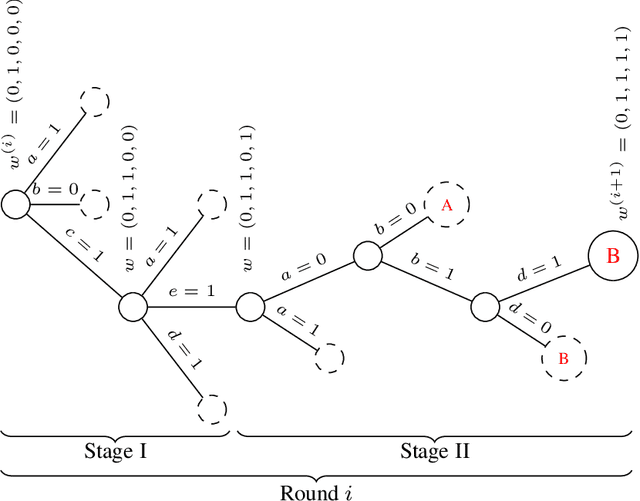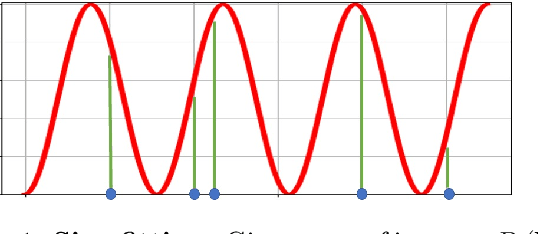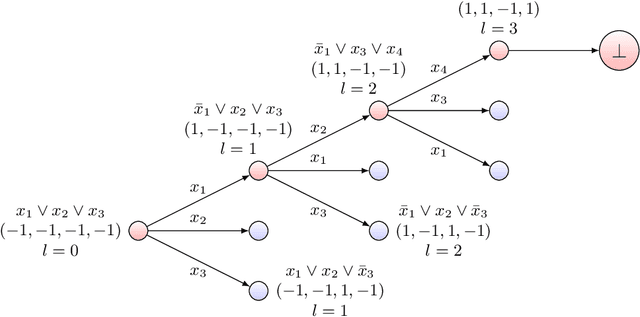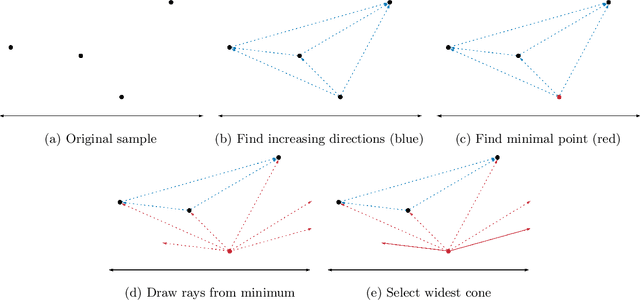Daniel Kane
Replicable Distribution Testing
Jul 03, 2025Abstract:We initiate a systematic investigation of distribution testing in the framework of algorithmic replicability. Specifically, given independent samples from a collection of probability distributions, the goal is to characterize the sample complexity of replicably testing natural properties of the underlying distributions. On the algorithmic front, we develop new replicable algorithms for testing closeness and independence of discrete distributions. On the lower bound front, we develop a new methodology for proving sample complexity lower bounds for replicable testing that may be of broader interest. As an application of our technique, we establish near-optimal sample complexity lower bounds for replicable uniformity testing -- answering an open question from prior work -- and closeness testing.
Replicability in High Dimensional Statistics
Jun 04, 2024Abstract:The replicability crisis is a major issue across nearly all areas of empirical science, calling for the formal study of replicability in statistics. Motivated in this context, [Impagliazzo, Lei, Pitassi, and Sorrell STOC 2022] introduced the notion of replicable learning algorithms, and gave basic procedures for $1$-dimensional tasks including statistical queries. In this work, we study the computational and statistical cost of replicability for several fundamental high dimensional statistical tasks, including multi-hypothesis testing and mean estimation. Our main contribution establishes a computational and statistical equivalence between optimal replicable algorithms and high dimensional isoperimetric tilings. As a consequence, we obtain matching sample complexity upper and lower bounds for replicable mean estimation of distributions with bounded covariance, resolving an open problem of [Bun, Gaboardi, Hopkins, Impagliazzo, Lei, Pitassi, Sivakumar, and Sorrell, STOC2023] and for the $N$-Coin Problem, resolving a problem of [Karbasi, Velegkas, Yang, and Zhou, NeurIPS2023] up to log factors. While our equivalence is computational, allowing us to shave log factors in sample complexity from the best known efficient algorithms, efficient isoperimetric tilings are not known. To circumvent this, we introduce several relaxed paradigms that do allow for sample and computationally efficient algorithms, including allowing pre-processing, adaptivity, and approximate replicability. In these cases we give efficient algorithms matching or beating the best known sample complexity for mean estimation and the coin problem, including a generic procedure that reduces the standard quadratic overhead of replicability to linear in expectation.
SQ Lower Bounds for Non-Gaussian Component Analysis with Weaker Assumptions
Mar 07, 2024Abstract:We study the complexity of Non-Gaussian Component Analysis (NGCA) in the Statistical Query (SQ) model. Prior work developed a general methodology to prove SQ lower bounds for this task that have been applicable to a wide range of contexts. In particular, it was known that for any univariate distribution $A$ satisfying certain conditions, distinguishing between a standard multivariate Gaussian and a distribution that behaves like $A$ in a random hidden direction and like a standard Gaussian in the orthogonal complement, is SQ-hard. The required conditions were that (1) $A$ matches many low-order moments with the standard univariate Gaussian, and (2) the chi-squared norm of $A$ with respect to the standard Gaussian is finite. While the moment-matching condition is necessary for hardness, the chi-squared condition was only required for technical reasons. In this work, we establish that the latter condition is indeed not necessary. In particular, we prove near-optimal SQ lower bounds for NGCA under the moment-matching condition only. Our result naturally generalizes to the setting of a hidden subspace. Leveraging our general SQ lower bound, we obtain near-optimal SQ lower bounds for a range of concrete estimation tasks where existing techniques provide sub-optimal or even vacuous guarantees.
Exponential Hardness of Reinforcement Learning with Linear Function Approximation
Feb 25, 2023
Abstract:A fundamental question in reinforcement learning theory is: suppose the optimal value functions are linear in given features, can we learn them efficiently? This problem's counterpart in supervised learning, linear regression, can be solved both statistically and computationally efficiently. Therefore, it was quite surprising when a recent work \cite{kane2022computational} showed a computational-statistical gap for linear reinforcement learning: even though there are polynomial sample-complexity algorithms, unless NP = RP, there are no polynomial time algorithms for this setting. In this work, we build on their result to show a computational lower bound, which is exponential in feature dimension and horizon, for linear reinforcement learning under the Randomized Exponential Time Hypothesis. To prove this we build a round-based game where in each round the learner is searching for an unknown vector in a unit hypercube. The rewards in this game are chosen such that if the learner achieves large reward, then the learner's actions can be used to simulate solving a variant of 3-SAT, where (a) each variable shows up in a bounded number of clauses (b) if an instance has no solutions then it also has no solutions that satisfy more than (1-$\epsilon$)-fraction of clauses. We use standard reductions to show this 3-SAT variant is approximately as hard as 3-SAT. Finally, we also show a lower bound optimized for horizon dependence that almost matches the best known upper bound of $\exp(\sqrt{H})$.
Coresets for Data Discretization and Sine Wave Fitting
Mar 06, 2022



Abstract:In the \emph{monitoring} problem, the input is an unbounded stream $P={p_1,p_2\cdots}$ of integers in $[N]:=\{1,\cdots,N\}$, that are obtained from a sensor (such as GPS or heart beats of a human). The goal (e.g., for anomaly detection) is to approximate the $n$ points received so far in $P$ by a single frequency $\sin$, e.g. $\min_{c\in C}cost(P,c)+\lambda(c)$, where $cost(P,c)=\sum_{i=1}^n \sin^2(\frac{2\pi}{N} p_ic)$, $C\subseteq [N]$ is a feasible set of solutions, and $\lambda$ is a given regularization function. For any approximation error $\varepsilon>0$, we prove that \emph{every} set $P$ of $n$ integers has a weighted subset $S\subseteq P$ (sometimes called core-set) of cardinality $|S|\in O(\log(N)^{O(1)})$ that approximates $cost(P,c)$ (for every $c\in [N]$) up to a multiplicative factor of $1\pm\varepsilon$. Using known coreset techniques, this implies streaming algorithms using only $O((\log(N)\log(n))^{O(1)})$ memory. Our results hold for a large family of functions. Experimental results and open source code are provided.
Computational-Statistical Gaps in Reinforcement Learning
Feb 11, 2022

Abstract:Reinforcement learning with function approximation has recently achieved tremendous results in applications with large state spaces. This empirical success has motivated a growing body of theoretical work proposing necessary and sufficient conditions under which efficient reinforcement learning is possible. From this line of work, a remarkably simple minimal sufficient condition has emerged for sample efficient reinforcement learning: MDPs with optimal value function $V^*$ and $Q^*$ linear in some known low-dimensional features. In this setting, recent works have designed sample efficient algorithms which require a number of samples polynomial in the feature dimension and independent of the size of state space. They however leave finding computationally efficient algorithms as future work and this is considered a major open problem in the community. In this work, we make progress on this open problem by presenting the first computational lower bound for RL with linear function approximation: unless NP=RP, no randomized polynomial time algorithm exists for deterministic transition MDPs with a constant number of actions and linear optimal value functions. To prove this, we show a reduction from Unique-Sat, where we convert a CNF formula into an MDP with deterministic transitions, constant number of actions and low dimensional linear optimal value functions. This result also exhibits the first computational-statistical gap in reinforcement learning with linear function approximation, as the underlying statistical problem is information-theoretically solvable with a polynomial number of queries, but no computationally efficient algorithm exists unless NP=RP. Finally, we also prove a quasi-polynomial time lower bound under the Randomized Exponential Time Hypothesis.
Realizable Learning is All You Need
Nov 08, 2021Abstract:The equivalence of realizable and agnostic learnability is a fundamental phenomenon in learning theory. With variants ranging from classical settings like PAC learning and regression to recent trends such as adversarially robust and private learning, it's surprising that we still lack a unified theory; traditional proofs of the equivalence tend to be disparate, and rely on strong model-specific assumptions like uniform convergence and sample compression. In this work, we give the first model-independent framework explaining the equivalence of realizable and agnostic learnability: a three-line blackbox reduction that simplifies, unifies, and extends our understanding across a wide variety of settings. This includes models with no known characterization of learnability such as learning with arbitrary distributional assumptions or general loss, as well as a host of other popular settings such as robust learning, partial learning, fair learning, and the statistical query model. More generally, we argue that the equivalence of realizable and agnostic learning is actually a special case of a broader phenomenon we call property generalization: any desirable property of a learning algorithm (e.g.\ noise tolerance, privacy, stability) that can be satisfied over finite hypothesis classes extends (possibly in some variation) to any learnable hypothesis class.
Boosting in the Presence of Massart Noise
Jun 14, 2021Abstract:We study the problem of boosting the accuracy of a weak learner in the (distribution-independent) PAC model with Massart noise. In the Massart noise model, the label of each example $x$ is independently misclassified with probability $\eta(x) \leq \eta$, where $\eta<1/2$. The Massart model lies between the random classification noise model and the agnostic model. Our main positive result is the first computationally efficient boosting algorithm in the presence of Massart noise that achieves misclassification error arbitrarily close to $\eta$. Prior to our work, no non-trivial booster was known in this setting. Moreover, we show that this error upper bound is best possible for polynomial-time black-box boosters, under standard cryptographic assumptions. Our upper and lower bounds characterize the complexity of boosting in the distribution-independent PAC model with Massart noise. As a simple application of our positive result, we give the first efficient Massart learner for unions of high-dimensional rectangles.
Bounded Memory Active Learning through Enriched Queries
Feb 09, 2021
Abstract:The explosive growth of easily-accessible unlabeled data has lead to growing interest in active learning, a paradigm in which data-hungry learning algorithms adaptively select informative examples in order to lower prohibitively expensive labeling costs. Unfortunately, in standard worst-case models of learning, the active setting often provides no improvement over non-adaptive algorithms. To combat this, a series of recent works have considered a model in which the learner may ask enriched queries beyond labels. While such models have seen success in drastically lowering label costs, they tend to come at the expense of requiring large amounts of memory. In this work, we study what families of classifiers can be learned in bounded memory. To this end, we introduce a novel streaming-variant of enriched-query active learning along with a natural combinatorial parameter called lossless sample compression that is sufficient for learning not only with bounded memory, but in a query-optimal and computationally efficient manner as well. Finally, we give three fundamental examples of classifier families with small, easy to compute lossless compression schemes when given access to basic enriched queries: axis-aligned rectangles, decision trees, and halfspaces in two dimensions.
Robustly Learning any Clusterable Mixture of Gaussians
May 13, 2020
Abstract:We study the efficient learnability of high-dimensional Gaussian mixtures in the outlier-robust setting, where a small constant fraction of the data is adversarially corrupted. We resolve the polynomial learnability of this problem when the components are pairwise separated in total variation distance. Specifically, we provide an algorithm that, for any constant number of components $k$, runs in polynomial time and learns the components of an $\epsilon$-corrupted $k$-mixture within information theoretically near-optimal error of $\tilde{O}(\epsilon)$, under the assumption that the overlap between any pair of components $P_i, P_j$ (i.e., the quantity $1-TV(P_i, P_j)$) is bounded by $\mathrm{poly}(\epsilon)$. Our separation condition is the qualitatively weakest assumption under which accurate clustering of the samples is possible. In particular, it allows for components with arbitrary covariances and for components with identical means, as long as their covariances differ sufficiently. Ours is the first polynomial time algorithm for this problem, even for $k=2$. Our algorithm follows the Sum-of-Squares based proofs to algorithms approach. Our main technical contribution is a new robust identifiability proof of clusters from a Gaussian mixture, which can be captured by the constant-degree Sum of Squares proof system. The key ingredients of this proof are a novel use of SoS-certifiable anti-concentration and a new characterization of pairs of Gaussians with small (dimension-independent) overlap in terms of their parameter distance.
 Add to Chrome
Add to Chrome Add to Firefox
Add to Firefox Add to Edge
Add to Edge